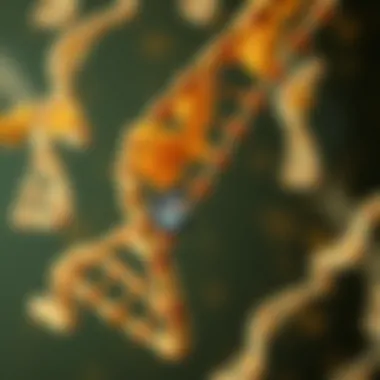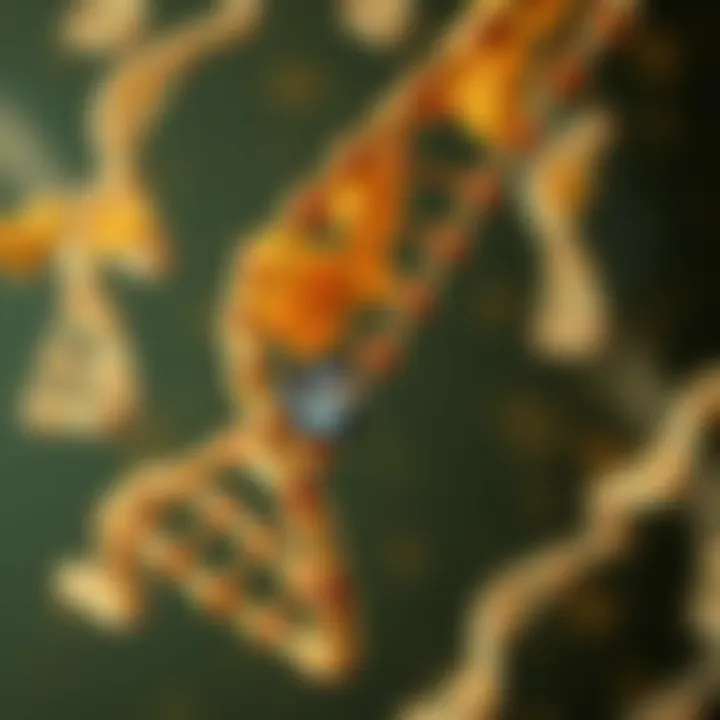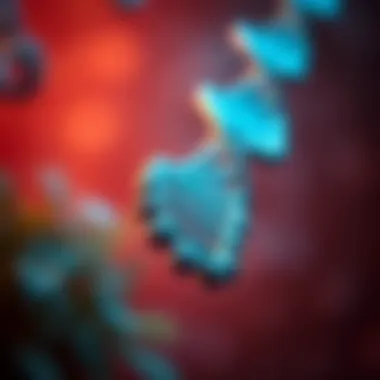Point Mutagenesis: Mechanisms and Applications


Intro
Point mutagenesis, the process of altering specific nucleotide sequences in DNA, plays a pivotal role in the landscape of genetics. By tweaking these minuscule yet significant elements, organisms exhibit a variety of traits, influencing everything from visibility to survivability. As we delve into this topic, it’s crucial to first understand the framework surrounding point mutations—this knowledge lays the foundation for comprehending its impact on natural selection and innovation in scientific fields.
Research Background
Overview of the Scientific Problem Addressed
At its core, point mutagenesis addresses the fundamental question: how do changes at a molecular level manifest in broader biological contexts? The propensity for DNA to undergo spontaneous mutations introduces variability, which is essential for the evolutionary process. Yet, these transformations can also lead to genetic disorders or unexpected consequences in the organism. Understanding the machinery behind these mutations allows researchers to harness or mitigate such effects, particularly in medical science and biotechnology.
Historical Context and Previous Studies
Historically, the concept of mutation hasn’t always been viewed with favor. In the 19th century, the terms ‘mutation’ often bore negative connotations. However, studies conducted throughout the 20th century laid the groundwork for a more nuanced understanding. The landmark discoveries regarding the structure of DNA by Watson and Crick in the 1950s highlighted how mutations could directly affect heredity. Subsequent research in genetics began to demystify the role of point mutations in species variation, from Sickle Cell Anemia, driven by a single nucleotide alteration in hemoglobin, to the development of antibiotic resistance in bacteria. It is this background that informs today’s exploration of mutagenesis.
Findings and Discussion
Key Results of the Research
Recent investigations into point mutagenesis have successfully isolated various mechanisms that drive these changes, such as deamination, mispairing during DNA replication, and the effects of environmental factors like UV radiation and chemical exposure. These findings indicate that not all mutations are created equal; some confer advantages while others can be detrimental.
Interpretation of the Findings
An important conclusion drawn from contemporary studies is that while mutations contribute to genetic diversity, they also are a double-edged sword. For instance, consider the case of the peppered moth; a single mutation resulted in a color change that allowed for better camouflage in polluted environments, demonstrating natural selection in action. Yet, when similar mutations occur in critical genes, the results can be catastrophic. The varying implications underscore the need for a balanced perspective when considering genetic alterations.
The gene editing discourse must thus focus not only on potential advancements but also on ethical dimensions of such technologies. The line between enhancement and alteration could have profound societal implications.
In summary, point mutagenesis provides a fascinating glimpse into the interplay between genetics and environmental adaptation, illuminated by historical precedents and modern discoveries. Through investigating the mechanisms and ramifications of these mutations, we can better grasp their significance, not only in natural selection but also in the future of medical and biotechnological advancements.
Relevant Resources
- Wikipedia - Mutation
- Britannica - Genetic Mutation
- National Institutes of Health - Genetics
- Reddit - Genetics
Prolusion to Point Mutagenesis
Point mutagenesis is more than just a lexical fancy; it’s like the subtle art of tweaking a single note in a symphony, shifting the harmony of life itself. Understanding this process is crucial for comprehending genetic variability, which is fundamental to evolution, but also critical in many applications ranging from medicine to biotechnology. With this article, we aim to illuminate the layers of this fascinating subject.
Definition and Overview
At its core, point mutagenesis refers to a molecular alteration that changes a specific nucleotide in the DNA sequence. Typically, one base pair is replaced by another; this can be a straight-up swap like a player switch on a football team. For example, if adenine (A) is replaced by guanine (G), it can lead to a cascading effect on how genes function. This simple alteration can have profound implications on protein structures and functions, directly influencing traits and health.
Understanding the types of point mutations—substitutions, insertions, and deletions—can help in figuring out their role in various biological processes. Substitutions can lead to silent mutations with no effect, or they might be harmful, giving rise to diseases. Insertions and deletions can cause frameshifts, potentially resulting in significant functional changes in proteins.
This overview sets the stage for a deeper dive into the mechanisms and broader implications of point mutations.
Historical Context
The journey of uncovering the mechanisms behind point mutations has roots extending far back into the early 20th century. Scientists like Gregor Mendel laid the groundwork in genetic principles, although the concept of mutations wasn't fully appreciated until later. Fast forward to the mid-1900s, nurtured by breakthroughs from figures like James Watson and Francis Crick, who unraveled the structure of the DNA helix. Their discoveries revealed the foundation for understanding how mutations occur on a molecular level.
Moreover, Avery, MacLeod, and McCarty in 1944 and later Hershey–Chase experiment in the 1950s led to a better grasp of how genetic information is transmitted and altered.
As technology evolved, so did the methodologies to detect and exploit these mutations. Techniques such as Sanger sequencing and polymerase chain reaction (PCR) have turned point mutagenesis into a tool of immense power. Gene editing tools like CRISPR promise unprecedented control over genetic material, amplifying the need to comprehend the implications of point mutations comprehensively.
The understanding of point mutagenesis is not just a biological curiosity but a critical component of many fields, including medicine, biotechnology, and agriculture.
From its humble beginnings to transformative advances, the historical context serves to underline why researchers—and indeed, humanity—must pay attention to the influence of even the tiniest changes in our genetic blueprint.
Mechanisms of Point Mutagenesis
The mechanics of point mutagenesis dive into the strategies underpinning how single nucleotide changes occur. These mechanisms play a pivotal role in shaping biology at various levels, affecting traits, evolution, and even the development of diseases. Understanding these processes is crucial not only for genetics enthusiasts but also for researchers aiming to manipulate or study genetic material in a lab setting.
Types of Mutations
Substitutions
Substitution mutations occur when one base pair is replaced by another. This could be as simple as swapping an A for a G or a C for a T. The significance of substitutions is that they can lead to changes in amino acids, resulting in proteins that may function differently. This type of mutation stands out because it can subtly alter the protein’s function without causing a complete loss of activity.
A prime example is the mutation in the hemoglobin gene that can lead to phenotypes like sickle cell disease. In this case, a single mutation in the beta-chain of hemoglobin causes troubles in oxygen transport. While substitutions might appear minor, they can result in substantial shifts in biological functions, making it a commonly researched phenomenon in genetics.
Insertions
Insertions are when one or more nucleotide bases are added into the sequence of DNA. This can cause a frame shift, which is when the reading frame of the genetic code is altered. It’s an interesting subplot in the larger narrative of genetics, as it can lead to new traits or even make certain proteins non-functional. Sometimes, insertions are utilized in genetic engineering to enhance the properties of a gene.
However, the downside is clear: insertions can wreck havoc, creating a cascade of unanticipated consequences if they land incorrectly within coding sequences. The diversity they can introduce may be beneficial, yet they also carry the risk of producing detrimental effects on the organism.
Deletions
Deletions involve the removal of nucleotide sequences from the genome, which can be just one base to perhaps several. They hold significant weight in mutation studies due to their potential to inactivate genes entirely, resulting in a loss of function that could be critical for survival. This characteristic gives deletions their own flavor, making them a common suspect in genetic abnormalities.
An example seen in some forms of muscular dystrophy illustrates the risks; deletions can disrupt critical muscle structure proteins. While deletions can be destructive, they might also yield beneficial outcomes through mechanisms such as gene conversion, where genes can vanish and then reappear in a different context.


Causes of Point Mutations
Spontaneous Mutations
Spontaneous mutations arise without any external influence. They can happen naturally during DNA replication or due to replication errors. The randomness of these mutations essentially means they’re unpredictable, but that doesn’t make them any less significant. Often, they are the fuel for genetic diversity, allowing evolution to pick and choose through natural selection.
While spontaneous mutations can create a richer gene pool, they come with a caveat. Many spontaneous mutations can also lead to genetic diseases, making their outcomes a bit of a double-edged sword in genetic studies.
Induced Mutations
Induced mutations occur as a result of environmental factors, such as radiation or the presence of certain chemicals. These external catalysts can actively provoke changes within the DNA, leading to alterations that might not have happened on their own.
They can be harnessed purposely in research, allowing specific traits to be developed or selected for. However, the manipulation of induced mutations can often lead to unfavorable consequences, including increased cancer risk which poses ethical questions about experimentation and safety.
Molecular Pathways in Mutation
DNA Replication Errors
Errors during DNA replication can occur significantly, leading to mutations. Sometimes, the repair mechanisms in place fail to catch these mistakes. This problem contributes to an ongoing cycle of genetic alteration, posing diverse implications on evolution and diversity. Errors are typically the byproduct of high-speed replicating machinery that occasionally stumbles, leading to mismatches.
Despite the typically high fidelity of DNA polymerases, errors happen, and the mutations introduced can serve as a basis of variation—the raw material for natural selection. This reality introduces both challenges and opportunities in understanding how genes evolve and adapt over time.
Repair Mechanisms
DNA repair mechanisms function as the body’s built-in defense against mutations. They constantly monitor and rectify errors that arise during replication or due to environmental damage. These systems can identify mismatches and excise the incorrect bases, making way for correct replacements.
Nevertheless, reliance on these repair systems can backfire; their failure leads to persistent mutations which can lead to tumorigenesis in severe cases. Understanding how these mechanisms operate is crucial as it potentially offers pathways to developing therapeutic strategies that could enhance genetic stability.
Biological Significance of Point Mutations
Point mutations play a pivotal role in the tapestry of life. They might seem like tiny alterations, yet these nicks in the genetic code carry immense consequences. In the context of evolution, genetic health, and biotechnology, understanding the significance of point mutations unveils a deeper appreciation of biological processes and their impacts on organisms.
Role in Evolution
Evolutionary biology often hinges on genetic variation, and point mutations fuel this variation. To put it simply, these mutations serve as the foundation upon which natural selection acts. For instance, consider the story of the peppered moth during the Industrial Revolution in England. The rise of pollution created a darker environment which favored moths with point mutations leading to darker pigmentation. This morphological change, driven by point mutations, improved their chances of survival against predators. Hence, point mutations don't merely exist in isolation; they are instrumental in shaping adaptive features that allow organisms to thrive in ever-changing environments.
Contribution to Genetic Diversity
Genetic diversity is the lifeblood of populations, enabling resilience against diseases and environmental changes. Point mutations drive this diversity by subtly altering gene sequences. A well-known example is the HLA gene family, which is crucial for immune responses. Variations in this gene can result from point mutations, offering a range of immunity profiles across human populations. This variability means that some individuals may be more resistant to certain pathogens than others, demonstrating how significant these minor changes can be in the big picture of human health.
Moreover, these mutations can lead to polymorphisms, variations that exist within a population. These polymorphisms are not only critical for survival but also benefit research in pharmacogenomics, helping tailor medical treatments to genetic profiles.
Impacts on Adaptation
Point mutations do not just contribute to diversity; they also directly assist species in adapting to new conditions. For instance, consider how we enjoy a variety of flavors in fruits. The variations in the Myrosinase gene have led to differences in cruciferous vegetables, impacting taste and nutritional value. Such adaptations can influence dietary patterns, agricultural production, and overall nutrition in human populations.
In the realm of microbiology, bacteria showcase rapid adaptability through point mutations, allowing them to survive in hostile environments, such as developing antibiotic resistance. This ability has substantial implications for public health. Simply put, jump-starting evolutionary adaptation through point mutations can help species survive challenges that could otherwise spell doom.
In summary, point mutations are not just trivial occurrences; they are the subtle changes that have propelled evolutionary processes, enhanced genetic diversity, and facilitated adaptation in countless organisms.
These narratives surrounding point mutations highlight their essential roles within the biological sphere. It becomes clear that these minute alterations greatly influence the trajectory of evolution, the robustness of genetic diversity, and the ability of species to adapt to their environments.
Human Health and Disease Implications
Understanding the impact of point mutations is vital for a number of reasons when it comes to human health. These mutations can lead to a host of diseases and conditions that affect people in different ways. The study of point mutations provides insight into the underlying mechanisms of these diseases, paving the way for new treatments and therapies. In this section, we will explore how point mutations relate to cancer, genetic disorders, and pharmacogenomics, emphasizing their significance and consequences.
Point Mutations in Cancer
Point mutations can act like a double-edged sword in oncology. At times, these tiny changes to DNA can initiate the process of cancer development. Genetic sequences that typically code for normal cell function can become altered, resulting in the production of abnormal proteins—or worse, allowing cells to proliferate unchecked.
For instance, the KRAS gene, known for its role in cellular signaling, is frequently mutated in many cancers such as pancreatic and colorectal cancer. A single alteration in this gene can flip the switch that leads to uncontrolled growth of tumors. These mutations serve not just as markers for diagnosis but also as targets for personalized therapies, representing a critical area of research in cancer treatment.
Genetic Disorders and Point Mutations
Sickle Cell Disease
Sickle Cell Disease (SCD) exemplifies how a point mutation can have profound clinical implications. Caused by a single nucleotide replacement in the HBB gene, which encodes the beta-globin subunit of hemoglobin, this mutation leads to the formation of abnormally shaped red blood cells. This alteration in shape makes it difficult for the cells to travel through blood vessels, often resulting in pain and increased risk of stroke.
This specific characteristic makes Sickle Cell Disease a prime example to discuss in this article. Understanding the mutation's biological basis not only sheds light on the disease's pathology but also guides advancements in treatment strategies, like gene therapy, aiming to correct the underlying genetic defect.
Cystic Fibrosis
Cystic Fibrosis (CF) is another genetic disorder linked to point mutations, primarily caused by a deletion of three nucleotides in the CFTR gene, which codes for a protein that regulates salt and water movement in cells. This disruption leads to thick, sticky mucus build-up in organs, particularly affecting the lungs and digestive system.
Focusing on Cystic Fibrosis is essential for our article because it highlights the broader implications of point mutations on organ function and health. The distinct pathways and treatment discoveries, such as CFTR modulators, arise from an understanding of how slight genetic changes can affect overall health. The study of mutations in CF not only enhances our comprehension of this condition but also raises awareness of potential treatments that could alleviate suffering and improve quality of life.
Point Mutations in Pharmacogenomics
Pharmacogenomics is an emerging field that studies how an individual's genetic makeup influences their response to medications. Point mutations can tremendously affect drug metabolism and efficacy. For instance, mutations in the CYP2D6 gene can lead to variations in how patients process certain drugs, resulting in significant differences in therapeutic outcomes.
Such understanding is crucial for personalized medicine. By analyzing point mutations and incorporating genetic screening into clinical practice, healthcare providers can tailor treatments to individual patients, maximizing effectiveness while minimizing side effects. This represents a shift toward a more individualized approach in medicine, influenced significantly by the underlying genetic factors.


In summary, point mutations illuminate critical pathways and mechanisms that greatly impact human health and disease. Their roles in cancer, genetic disorders, and pharmacogenomics underscore their significance, shaping future research and therapeutic strategies.
Techniques for Detecting Point Mutations
Detecting point mutations is crucial for various fields of biological research, especially when aiming to understand genetic diseases, evolutionary biology, and the development of new therapies. These mutations, which can change a single nucleotide in the DNA sequence, may have significant functional consequences. The arsenal of techniques available to researchers includes several state-of-the-art tools that vary in complexity, accuracy, and resolution. Each method has its strengths and challenges, and understanding them can aid in making informed choices in a research setting.
Sequencing Technologies
Sanger Sequencing
Sanger Sequencing, often called chain termination sequencing, was developed in the 1970s and remains a popular approach for precision. A notable aspect of this technique is its high accuracy, which derives from the use of dideoxynucleotides. These specially modified nucleotides terminate DNA strand elongation, allowing for the detection of extensions that correlate to the original template sequence. This is particularly beneficial for validating small point mutations due to its reliability.
One of the key characteristics of Sanger Sequencing is its capacity to generate long reads, typically up to 1,000 base pairs. This makes it especially suitable for sequencing individual genes or small genomic regions, providing a clear view into areas of interest. However, its limitations include a relatively higher cost per base compared to newer methods and its lower throughput, meaning it’s not ideal for large-scale genomic projects.
In summary, Sanger Sequencing is heralded for its precision and is a trusty choice for many applications, especially where accuracy reigns supreme. However, researchers should weigh its costs against their specific needs, as it may not be suitable for extensive investigations.
Next-Generation Sequencing
Next-Generation Sequencing (NGS) marks a paradigm shift in the tools available for detecting point mutations. This method facilitates the parallel sequencing of millions of DNA fragments, resulting in an exponential increase in data generation and a substantial reduction in costs per base. The sheer scale of NGS enables comprehensive analyses of whole genomes, making it indispensable for large-scale studies and population genetics.
A striking feature of NGS is its ability to produce vast amounts of data in a relatively short time frame. This capacity allows researchers to detect point mutations across diverse samples effortlessly. However, NGS does come with its own set of hurdles, particularly concerning data analysis and interpretation, which can be overwhelming due to the complexity of the datasets generated.
While NGS revolutionized the detection of point mutations, researchers must recognize that the accuracy of detection can vary based on the approach used within NGS. Special care in bioinformatics strategies is needed to ensure the quality of data interpretation, underscoring the importance of having skilled analysts in the field.
PCR and Mutant Detection
Polymerase Chain Reaction (PCR) is a cornerstone technique for amplifying specific DNA sequences, which directly aids in the detection of point mutations. By designing primers that flank the region of interest, PCR enables the selective amplification of mutated genes. The resulting product can then be analyzed using various methods, including sequencing or gel electrophoresis, to determine the presence of mutations.
One of the advantages of PCR is its sensitivity; it can amplify very small amounts of DNA, making it ideal for detecting mutations in samples where DNA is limited. However, the technique is not without its pitfalls; primer design must be meticulously considered to avoid amplifying non-target sequences, and the amplification process can sometimes introduce errors.
Consequently, PCR often works best in conjunction with other techniques for detection, providing a robust framework for identifying mutations effectively.
Bioinformatics Approaches
Bioinformatics has become instrumental in the detection of point mutations, especially given the rise of large-scale sequencing projects. These approaches involve analyzing vast datasets generated from sequencing technologies like NGS. Software tools analyze sequences to identify mutations, providing significant insights into the genetic basis of diseases and evolutionary processes.
Using bioinformatics tools enables researchers to easily compare genetic sequences across populations, identify patterns of mutation frequency, and assess potential functional impacts. However, bioinformatics is only as good as the data it processes; thus, quality control in data acquisition is paramount to ensure accurate results.
In essence, bioinformatics enhances the capability to detect point mutations beyond mere identification; it facilitates the interpretation of biological significance, making it an invaluable asset in modern genetics research.
Applications of Point Mutagenesis
Point mutagenesis has making its mark across various fields, impacting both theoretical research and practical applications. Understanding its potential in biotechnology, synthetic biology, and agricultural biotechnology is essential for harnessing its benefits while also considering the accompanying challenges.
Biotechnology and Genetic Engineering
In the realm of biotechnology, point mutagenesis serves as a cornerstone for advancing genetic engineering techniques. Through targeted mutations, scientists can generate organisms with desirable traits. For example, researchers often use techniques to manipulate enzymes for industrial applications, thereby increasing their efficiency and stability. An excellent illustration of this is the use of point mutations in microorganisms like E. coli, enhancing their ability to produce biopharmaceuticals or biofuels, which ultimately contributes to a more sustainable future.
Moreover, creating animal models that possess specific genetic mutations allows for deeper insights into human diseases. This practice not only sheds light on potential therapies but also advances our understanding of pathophysiological mechanisms in various disorders. Key benefits include:
- Targeted modifications: Fine-tuning genetic outcomes at precise loci.
- Reduced off-target effects: Enhancing specificity through refined methods.
These applications highlight how biotechnology is interwoven with point mutagenesis, fostering innovation and practical solutions across industries.
Synthetic Biology Approaches
Synthetic biology, an emerging field combining biology and engineering, leverages point mutagenesis as a toolkit for designing novel biological systems. Point mutations offer a precise way to alter genetic circuits, allowing researchers to construct pathways that can, for instance, produce new materials or bioactive compounds. Techniques like CRISPR, which involves point mutagenesis, can enable the customization of organisms for various purposes, including bioremediation or producing renewable energy.
However, while the prospects are bright, there are considerations to bear in mind. The ethical implications around creating organisms with novel functions provoke important discussions regarding ecological balance and biosafety. Existing frameworks for synthetic biology are evolving, necessitating collaboration across disciplines to address these challenges effectively. With advancements in bioinformatics, synthetic biologists can predict the outcomes of genetic alterations more reliably, making it a more justifiable pursuit.
Agricultural Biotechnology
Point mutagenesis has revolutionary potential in agricultural biotechnology, where it aids in developing crops that are resilient to environmental stresses such as drought, pests, or diseases. For instance, scientists have harnessed point mutations to develop rice varieties that better withstand certain pathogens, thereby ensuring food security in vulnerable regions.
Moreover, genetically modified organisms can exhibit improved nutritional content or enhanced growth rates, benefiting both farmers and consumers. Some key contributions of point mutagenesis in agriculture include:
- Increased yield: Modifying genes associated with plant growth.
- Enhanced resistance: Cultivating crops that can thrive in challenging climates.
While the advantages are compelling, ethical considerations regarding genetically modified crops must be addressed. Consumer perceptions, health implications, and environmental impacts all play significant roles in the public dialogue surrounding this technology. As such, ongoing research must be accompanied by transparent communication and regulatory oversight to ensure that advancements in agricultural biotechnology promote sustainable practices.
Ethical Considerations and Controversies
The advances in the domain of point mutagenesis have triggered a whirlwind of ethical debates. These discussions are absolutely essential because they address the profound implications of human intervention in genetic material. Delving into the ethical dilemmas birthed by gene editing technologies, this section helps map out both the challenges and responsibilities that come with newfound capabilities in genetics.
Gene Editing in Humans
Gene editing in humans, a controversial yet fascinating aspect of point mutagenesis, presents a landscape filled with possibilities and pitfalls. One major focus is the potential benefits of eradicating genetic disorders. For instance, utilizing CRISPR technology to correct mutations responsible for conditions like Duchenne Muscular Dystrophy can revolutionize treatment options. However, the slippery slope of genetic modifications raises moral questions about designer babies and the societal implications of creating genetically enhanced individuals.
On the one hand, proponents argue that correcting mutations can eliminate suffering and improve the overall quality of life. Yet, critics emphasize the need for stringent regulations to avoid unintended consequences and to preserve genetic diversity. Here are some key points to ponder:


- Informed Consent: Parents must be fully aware of the implications when considering genetic alterations for their offspring.
- Equity in Access: Access to gene editing technologies may not be uniform, thereby widening the gap between social classes.
- Long-term Effects: The long-term effects of gene editing are still unclear; modifying one gene might lead to unforeseen consequences in another.
Environmental Concerns
When discussing point mutagenesis, one cannot overlook the environmental ramifications, especially regarding crop modifications. Genetic engineering in agriculture can offer benefits such as increased yield and pest resistance. Crops engineered to endure harsher climates can play a critical role in food security. However, the introduction of genetically modified organisms (GMOs) sparks concerns about biodiversity and ecosystem health.
There are a few issues worth noting:
- Gene Flow: The unintended transfer of modified genes to wild relatives may disrupt natural ecosystems.
- Resistance Development: Pests and weeds may evolve resistance to genetically engineered traits, leading to a cycle of dependency on chemical inputs.
- Public Perception: Societal views on GMOs can sway public support and regulatory policies, making it crucial for researchers to engage in transparent communication.
Regulatory Frameworks
The establishment of regulatory frameworks around point mutagenesis is an intricate task. Governments and scientific bodies are tasked with balancing innovation with safety. Different countries have adopted varying approaches toward genetic modification. For example, the European Union adopts a cautious stance, enacting stringent guidelines for gene editing, while other regions may facilitate faster approvals.
Some pivotal components of regulatory frameworks include:
- Risk Assessment: Comprehensive evaluations must determine the safety of genetically modified organisms for human consumption and the environment.
- Ethical Review Boards: Institutions often implement review boards to oversee research proposals involving gene editing, ensuring ethical considerations are prioritized.
- Public Engagement: Openness about the goals and limitations of point mutagenesis fosters trust and informed public opinion.
"The future of genetic editing is not merely a scientific issue but a profound ethical challenge that our society must face."
Thus, as we navigate the realm of point mutagenesis, it is imperative that ethical considerations remain in sharp focus. Ensuring responsible use of gene editing technologies requires constant dialogue among scientists, ethicists, policymakers, and the public to foster an approach that serves humanity responsibly.
Future Directions in Point Mutagenesis Research
The realm of point mutagenesis is ever-evolving, offering fascinating prospects for future research. Understanding upcoming trends is not just essential but also pivotal for enhancing our grip on genetic engineering, conservation efforts, and disease treatment. As scientists delve deeper, they unearth new questions and applications that could directly impact both human health and agricultural practices.
In this section, we’ll explore advancements in technology, interdisciplinary approaches, and long-term implications that shape the future landscape of point mutagenesis.
Technological Advancements
CRISPR Technology
When discussing innovations in gene editing, CRISPR technology stands out like a beacon. This method provides a distinct edge in performing precise edits to genetic material. One of its key characteristics is its ability to target specific DNA segments with remarkable accuracy, which significantly reduces off-target effects that have hindered previous approaches. Due to this precision, researchers find CRISPR not just widely adopted, but also a core tool for understanding genetic variations arising from point mutations.
A unique feature must also be noted: ease of use. Many laboratory settings are quickly adopting CRISPR technologies, thanks to simplified protocols. However, this ease doesn't come without complications; ethical concerns around potential off-target effects loom large, necessitating stringent regulatory scrutiny.
"With great power comes great responsibility. The application of CRISPR technology is no exception."
Gene Therapy Innovations
In terms of innovative strides, gene therapy innovations pave a path toward treating genetic disorders at their core. This field utilizes targeted approaches to alter genetic material, often focusing on correcting mutations causing diseases. One of the primary allurements of gene therapy is its potential to provide permanent solutions. Unlike conventional treatments that may manage symptoms, gene therapy seeks to eliminate the root cause of disorders such as Duchenne Muscular Dystrophy and certain inherited cancers.
A standout aspect of gene therapy innovations is the combination of therapies. For instance, using viruses as vectors to deliver corrected genes has expanded into utilizing nanoparticles and other methods. While the advantages are compelling, including durability of effects and personalized medicine, significant hurdles remain. Addressing delivery efficiency and long-term safety are paramount, and ongoing discussions are crucial to resolving these challenges.
Interdisciplinary Approaches
In moving forward, a significant focus must be placed on interdisciplinary approaches in point mutagenesis research. Often, breakthroughs happen at the intersections of diverse fields. Biologists, chemists, bioinformaticians, and ethicists collaborating can yield comprehensive insights into how genetic alterations can be utilized beneficially while considering potential societal impacts. For instance, mathematical modeling can project the outcomes of specific mutations in ecosystems, blending theoretical and practical knowledge effectively.
The necessity of communication across disciplines will not only scientifically enrich the field, but it can also ensure that ethical considerations remain front and center, enhancing public trust in genetic research.
Long-Term Implications
As researchers and practitioners push the boundaries, it is crucial to consider the long-term implications of point mutagenesis. One aspect is its potential impact on biodiversity. While generating beneficial mutations may help in agriculture and medicine, an unchecked approach could threaten natural ecosystems if transgenes escape into wild populations. Regulatory bodies are in a challenging position to balance innovation with environmental stewardship.
Additionally, continuous monitoring of gene therapies' societal acceptance is vital. How individuals perceive and adapt to these technologies will shape public health policies in the years to come.
In summary, the future of point mutagenesis research holds abundant promise, yet carries considerable responsibility. As we leverage technological advancements, adopt interdisciplinary methodologies, and weigh long-term implications, a thoughtful and methodical approach is essential for harnessing this potent area of science responsibly.
Resources for further reading:
- CRISPR Basics
- Gene Therapy Overview
- Ethics of Genetic Engineering
- National Institutes of Health
- Genetics Home Reference
Closure
In recapping the profound scope of point mutagenesis, it becomes evident that the implications stretch far beyond the mere alteration of nucleotide sequences. This process catalyzes a myriad of influences on genetic variation, showcasing its significance in fields as diverse as evolutionary biology and medical research.
Key Aspects to Consider
The article has traversed the mechanisms underpinning point mutations, highlighting several specific elements worthy of note:
- Diversity in Mutations: Point mutations can result from both natural and induced processes, impacting genetic outcomes in ways that inform both natural selection and biotechnological applications.
- Significance in Health: The relationship between point mutations and diseases like cancer or genetic disorders illustrates how understanding these mutations can lead to better prevention and treatment strategies.
- Ethical Dimensions: As gene editing technologies advance, ethical considerations loom large. The responsibility that accompanies these powerful tools necessitates a discussion about their societal implications and regulatory frameworks.
"The more we explore point mutagenesis, the clearer it becomes that the genetic blueprint of life is intricately linked to both the balance of nature and the innovations of technology."
Benefits and Future Considerations
As we delve deeper into the realm of point mutagenesis, a few benefits emerge clearly:
- Enhanced Crop Resilience: In agriculture, the applications of point mutations can lead to enhanced traits in crops, supporting food security in the face of climate change.
- Personalized Medicine: In healthcare, the ability to understand individual genetic variations paves the way for tailored treatment plans, optimizing therapeutic efficacy.
- Research Advancement: With advancing techniques for detecting mutations, our ability to understand genetic diseases and evolutionary processes is rapidly improving.
Ultimately, the conclusions drawn from this exploration not only represent the state of current knowledge, but also lay the groundwork for future inquiries. In wrap-up, the journey through point mutagenesis has illuminated the intricate dance between genetics, health, and ethics, underscoring the need for a thoughtful, informed approach as we move ahead in this complex scientific landscape.
For further reading and resources, interested readers can explore:
Through this lens, the ongoing discourse surrounding point mutagenesis remains vital for both the scientific community and society at large.







